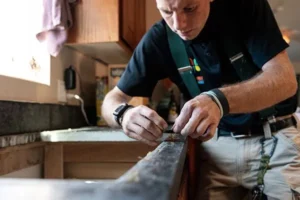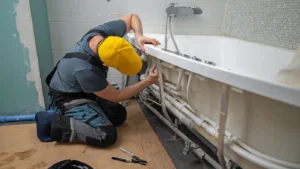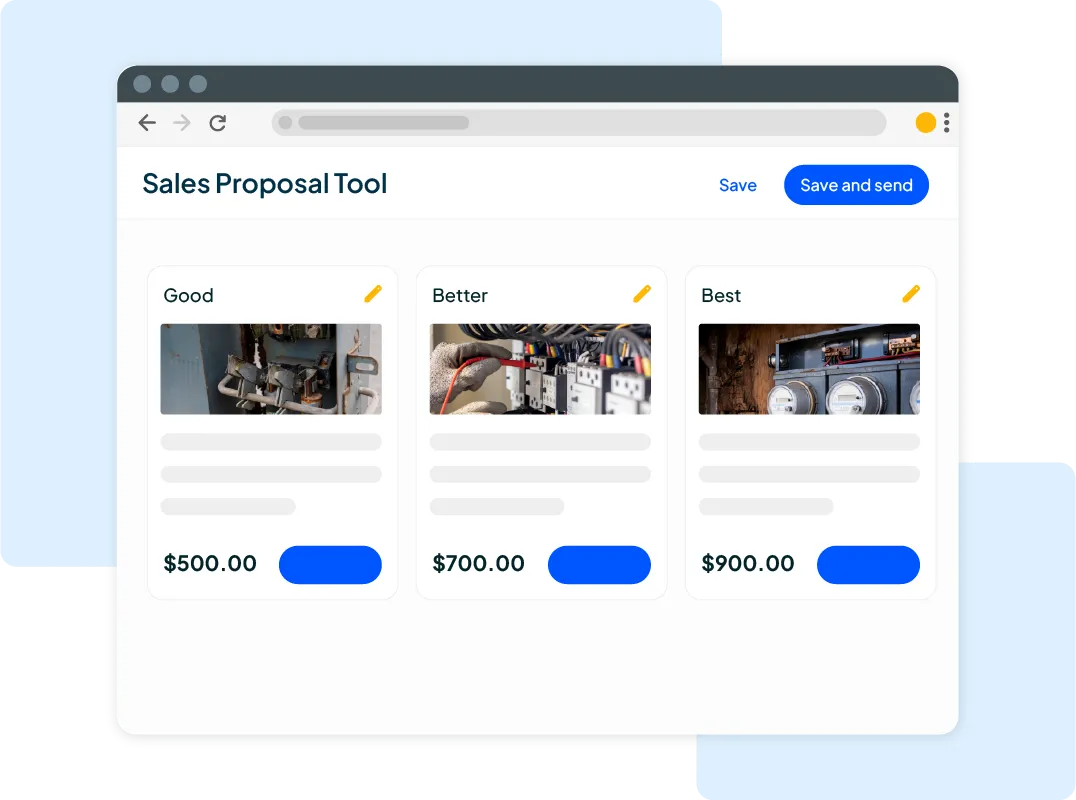Want to win more jobs with less effort?
Grow your business and send quick quotes with our home service software.

Want to see your potential revenue?
See what businesses like yours earn with Housecall Pro in 1 - 2 minutes.
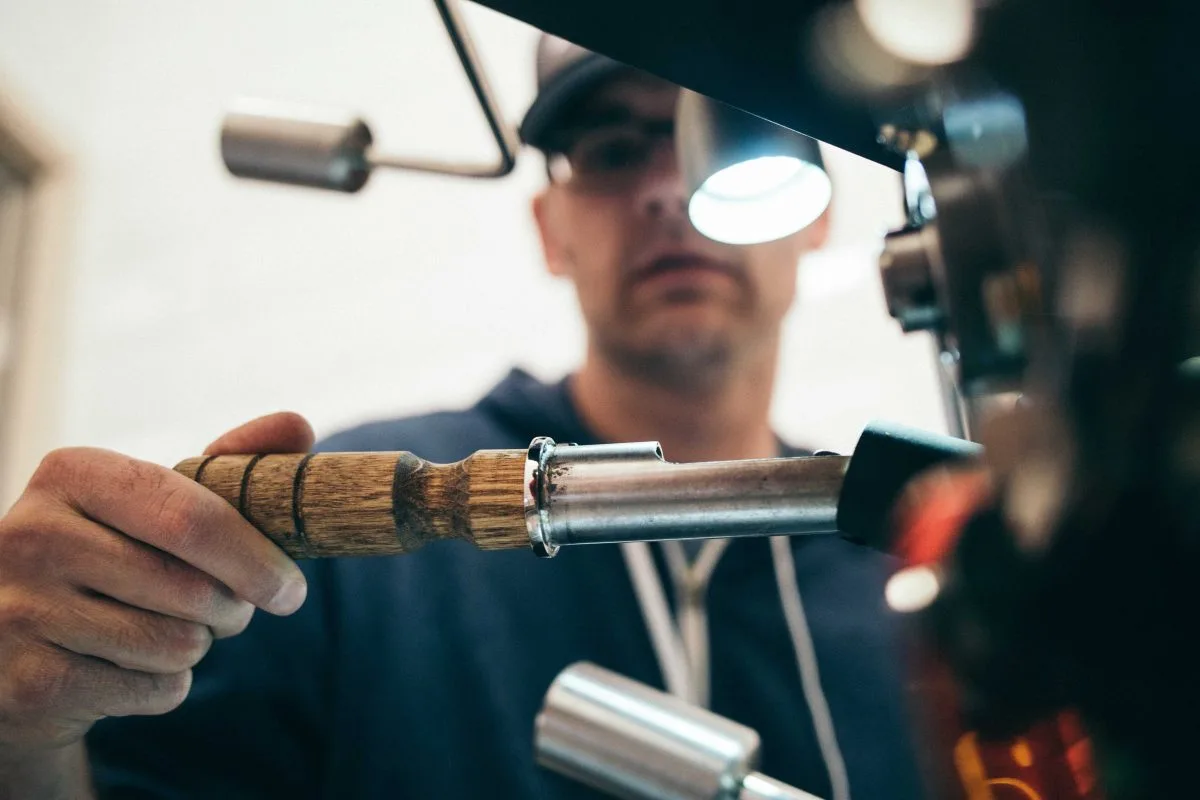
Pricing handyman jobs correctly is the foundation of a profitable business. You need to set rates that cover your expenses and protect your time while giving customers a fair, consistent experience.
To help you benchmark your costs, this guide breaks down average handyman rates in 2025. We’ll also explain how to calculate labor and overhead costs and create estimates that match the scope of each job.
→ Want to skip the math? Download our free handyman price list template or try Housecall Pro to auto-calculate costs and keep your pricing consistent from one project to the next.
Key takeaways
Here are the basics for pricing handyman jobs fairly and profitably.
Handyman hourly pricing: Most handymen charge $60–$85 per hour, with higher rates for advanced skills or complex jobs.
Flat-rate plus hourly options: Predictable handyman jobs often cost $150–$600, while more complicated work is usually billed hourly.
Overhead matters: Your rates should cover insurance, tools, vehicle costs, fuel, and admin time to stay profitable.
Markup keeps jobs sustainable: A 20%–50% material markup helps cover sourcing time, transportation, and other costs.
Learn how much to charge for handyman jobs
- Average handyman hourly rates (2025)
- What is the average cost of a handyman job?
- How to price handyman jobs step by step
- Step 1: Calculate your overhead costs
- Step 2: Choose a pricing model
- Step 3: Adjust your pricing based on job complexity
- Step 4: Add fees to protect your profit
- Step 5: Build an itemized handyman estimate
- Step 6: Use handyman pricing software to streamline your workflow
- Step 7: Communicate your pricing clearly to customers
- Step 8: Update and adjust your rates regularly
- Step 9: Build client trust by providing more value
- Step 1: Calculate your overhead costs
- Handyman pricing cheat sheet (2025)
- How Housecall Pro’s handyman software can help
- Pricing data methodology
Average handyman hourly rates (2025)
Handyman hourly rates vary based on location, experience, job complexity, and specialization. Most handymen charge between $50 and $150 per hour, with the national average falling between $60 and $85 per hour.
Here’s a look at how handyman hourly rates by business type:
| Type of Handyman | Typical Hourly Rate | Notes |
| Self-employed | $50–$80 | Flexible pricing; varies by experience & demand |
| Corporate / Franchise | $75–$125 | Higher overhead, standardized pricing |
| Specialized handyman | $75–$150 | Light electrical, minor plumbing, smart home installs |
*All prices in the guide reflect 2025 data from HomeGuide, Angi, and Thumbtack.
The prices in the above table are for everyday tasks like drywall patching, basic carpentry, fixture replacement, caulking, and small home repairs. Market competition, job difficulty, and scheduling all play a major role in determining the final price.
Hourly rates tend to fall on the lower end in:
- Smaller towns or rural areas, where operating costs and demand are lower
- Markets with many competing handymen, which drives pricing downward
- Jobs requiring standard tools and basic skills, such as patching, painting, or minor repairs
Rates move toward the higher end in:
- Large metropolitan areas with higher living and business expenses
- Jobs requiring multi-skill expertise, like combining carpentry and electrical
- Situations where access is difficult or time-consuming, such as attic repairs or crawl spaces
Because general handyman jobs vary so widely, hourly pricing is the most common way to bill these tasks. However, many pros still use flat-rate pricing for predictable jobs to streamline estimating.
Self-employed handyman hourly rate
Self-employed handymen typically charge $50–$80 per hour, making them one of the most flexible and competitive segments of the industry. The appropriate rate depends on your experience, the types of services you offer, and how busy your schedule is. In many cases, self-employed pros set prices based on real-time demand rather than following a fixed corporate price sheet.
Hourly rates for self-employed handymen increase significantly in:
- Urban or high-cost-of-living areas, where fuel, insurance, and materials are more expensive
- High-demand markets with limited competition, especially during peak seasons or after storms
- Jobs requiring advanced troubleshooting or special tools, such as electrical diagnostics, custom carpentry, or smart home integration
Experienced solo handymen often charge as much—or more—than corporate providers because they work efficiently, diagnose problems faster, and avoid the overhead that comes with franchise operations.
Specialized handyman rates per hour
Specialized handymen handle tasks that require a higher level of expertise, specialized tools, and sometimes licensing or certifications, which justifies a higher rate. These handymen typically charge $75-$150 for tasks like light electrical work, minor plumbing, appliance installation, smart home setup, flooring repairs, or advanced carpentry.
Rates for specialized services increase when:
- Jobs involve risk, such as electrical wiring or structural changes
- Specialty tools or diagnostic equipment are needed
- The work requires certification, permitting, or code compliance
- The skill level needed exceeds basic handyman training
- Projects require advanced troubleshooting, not just installation
Customers often expect to pay more for specialized handyman services because these jobs reduce safety risks and help avoid costly mistakes. Many handymen with multi-trade expertise (carpentry, electrical, plumbing) position themselves at the premium end of the market and can charge rates comparable to licensed trades in certain scenarios.
What is the average cost of a handyman job?
The average cost of a handyman job in 2025 is $150–$600, depending on the project size, labor time, materials required, and skill level involved. Smaller tasks like installing appliances or patching drywall fall closer to the lower end, while multi-step repairs or projects requiring specialty tools land at the higher end. Homeowners often prefer flat-rate pricing for predictable jobs because it eliminates guesswork and speeds up approvals.
| Job Size | Typical Price Range | Estimated Labor Hours | Description | Common Examples |
| Small jobs | $150–$250 | 0.5–2 hours | Quick projects that require minimal tools and limited setup time | -Fixing door hardware -Small drywall patching -Basic caulking |
| Medium jobs | $250–$450 | 2–4 hours | Jobs w/ multiple steps or minor electrical & carpentry | -Mounting TVs -Replacing light fixtures -Smart home setup |
| Large or complex jobs | $500–$1,500+ | 4–8+ hours | Projects needing advanced skills, specialty tools, or extended labor | -Floor, deck, or fence repairs -Minor plumbing/ electrical work |
How to price handyman jobs step by step
To price handyman work consistently, you need a process you can rely on for every job. Having a standardized method will ensure you cover your overhead, protect your profit margin, and deliver accurate estimates no matter the job size or complexity. Follow the steps below.
→ Want a faster way to price? Try our handyman service price calculator to set rates quickly.
Step 1: Calculate your overhead costs
Before you set prices, you need to know how much it costs to run your handyman business. Overhead includes expenses that aren’t tied to a specific job but impact your profitability every day. This means insurance, licensing fees, vehicle costs, office supplies, software, marketing, and any other recurring expenses that keep your business running.
Overhead formula
Monthly Overhead ÷ Monthly Billable Hours = Overhead Cost Per Hour
Example
If your monthly overhead is $2,400 and you can reasonably bill 120 hours per month:
$2,400 ÷ 120 = $20 overhead per hour
This means you need to add at least $20/hour to your labor rate just to break even.
Step 2: Choose a pricing model
Your pricing model determines how customers perceive your value and how predictable your income is. Hourly billing works best for troubleshooting, while flat-rate pricing gives customers more transparency. Many handymen use a hybrid model to stay competitive while protecting their profit on unpredictable work.
Hourly pricing example
A job takes 2.5 hours at $75/hr:
2.5 × $75 = $187.50 total labor
→ Try our handyman labor calculator to speed up the math.
Flat-rate pricing example
If you know ceiling fan installs take 1.5–2 hours and your rate is $75/hr + $20/hr overhead:
- Base labor: 2 hours × $75 = $150
- Overhead: 2 × $20 = $40
- Profit margin (25%): $47.50
- Flat-rate price = $237.50
→ Free download: Try our handyman flat-rate pricing template for a quick start.
Hybrid pricing example
Hybrid pricing gives customers clarity and gives you flexibility, allowing you to charge flat rates for predictable work and hourly rates when the job scope is uncertain.
- Minimum service fee: $125
- Flat-rate for simple repairs
- Hourly for complex or uncertain tasks ($75/hr)
Pro tip: Use flat-rate pricing for the top 10–15 jobs you do the most. It reduces sticker shock, speeds up approvals, and keeps your pricing consistent.
Step 3: Adjust your pricing based on job complexity
Not all handyman jobs require the same amount of time, tools, or technical skill. More complex projects introduce risk and specialized problem-solving, which should be reflected in your price. Increasing your rate for hazardous, multi-step, or hard-to-reach work ensures the job remains profitable.
Complexity adjustment example
Your normal hourly rate: $75/hr
Complexity multiplier: +20%
$75 + (20% of $75) = $90/hr adjusted rate
A three-hour job becomes:
3 × $90 = $270
Pro tip: Assume complex jobs will take 20%–30% longer than your first estimate. Underestimating labor is the fastest way to lose profit.
Step 4: Add fees to protect your profit
Additional fees ensure you’re paid fairly for the “invisible time” that every job requires: driving, setup, sourcing materials, and administrative work. These charges protect your margins and keep small jobs or long-distance calls from becoming financial losses. Clear, upfront communication helps customers understand why these fees exist.
Minimum service fee
Even the simplest job requires time that isn’t directly billable. Travel, setup, breakdown, and messaging often take an hour of your day before any tools come out.
Example:
- Round-trip travel: 40 minutes
- Setup + cleanup: 10 minutes
- Admin time (scheduling, messages, invoicing): 10 minutes
- Total nonbillable time: ~60 minutes
If your hourly rate is $75/hr, that invisible hour is worth $75. Add typical handyman overhead (about $20/hr for tools, insurance, vehicle costs, software), and your real cost is around $95. A minimum service fee of $125–$150 ensures small jobs stay profitable.
Trip fee
A trip fee compensates you for time spent driving and the wear on your vehicle, both of which limit how many jobs you can complete per day. This is applicable for jobs that are out of your normal service areas.
Example
- Round-trip driving: 45 minutes
- Labor value of 45 minutes at $75/hr: $56.25
- Vehicle wear + fuel (22 miles × $0.65/mile): $14.30
Estimated travel cost: $70.55
Most handymen charge a $60–$70 trip fee depending on distance. Any potential tolls and parking fees that could also be added in.
Material markup
Material markup covers sourcing time, transportation, warranty responsibility, and the risk of returns. This is standard across every home service trade.
Example
- Material cost: $200
- Markup: 30%
$200 × 0.30 = $60 markup
$200 + $60 = $260 final materials charge
Typical handyman markups range from 20%–50% depending on the job.
Get In Touch: 858-842-5746
Let us earn your trust
On average, Pros increase monthly revenue generated through Housecall Pro by 35% after their first year.
See plan options and feature breakdown on our pricing page.
Step 5: Build an itemized handyman estimate
A detailed estimate sets expectations by showing the customer exactly what they’re paying for. It also creates a clear paper trail, so if the customer later requests extra work or discovers additional damage, you can point back to the original scope and explain why new charges are necessary.
→ Free download: Use our free handyman quote template to simplify your workflow, look professional, and track every detail accurately.
Estimate example
Let’s say you’re preparing an estimate for a small to medium repair job, like replacing a damaged section of drywall and repainting it:
- Labor: 3 hours @ $75/hr = $225
- Materials + markup = $156
- Trip fee: $60
- Taxes: $18
- Total: $459
Presenting an itemized breakdown like the one above is much clearer—and more professional—than just quoting “$200–$300.”
Pro tip: Add photos to your estimates whenever possible. Visual documentation increases approval rates and helps justify pricing.
Step 6: Use handyman pricing software to streamline your workflow
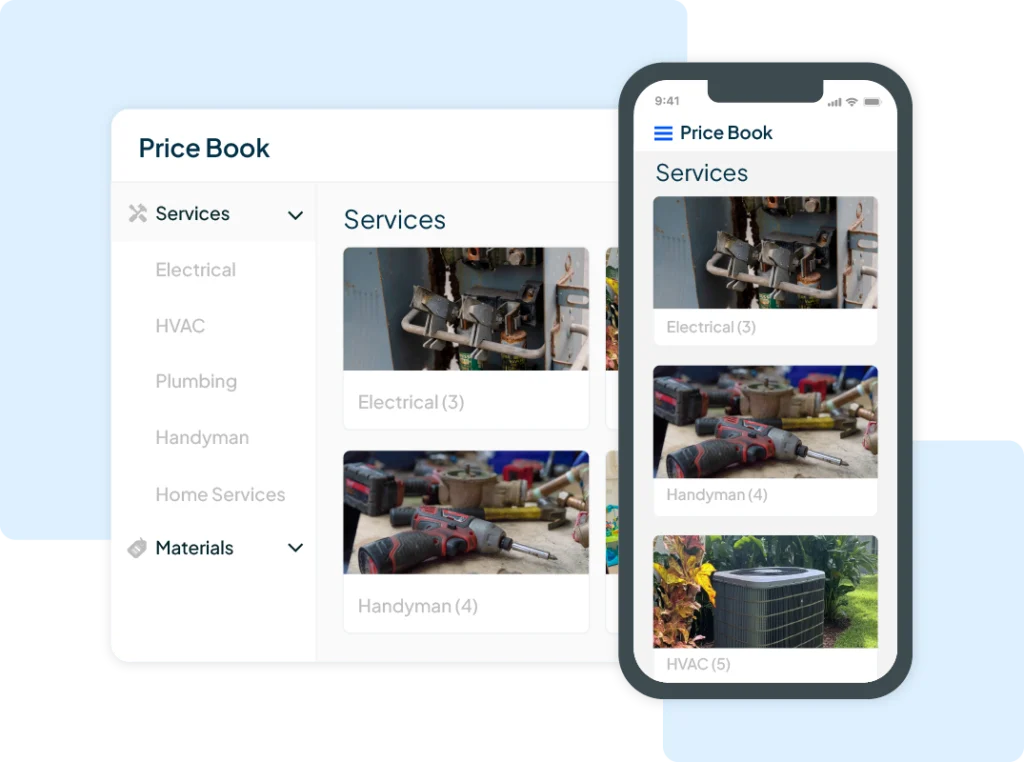
Handyman software eliminates guesswork and helps you stay consistent from job to job. These tools can automate calculations, track real material costs, and organize service prices so you never have to rely on memory or rough estimates again.
Example: Building a price book with software
Let’s say you set up the following flat-rate prices for common handyman jobs inside Housecall Pro:
- Ceiling fan install: $225 flat rate
- Faucet replacement: $180 flat rate
- TV mounting (standard): $199 flat rate
- Gutter cleaning: $150–$300, depending on size
Every estimate now pulls from the same preset pricing, ensuring consistency and eliminating on-the-spot math.
Example: Tracking real costs
A pro uses our Job Costing feature to compare estimated vs. actual costs:
- Estimated materials: $90
- Actual materials: $112
- Time estimated: 2 hours
- Time spent: 2.7 hours
The software flags this as underpriced, prompting you to update your flat-rate for future jobs.
Step 7: Communicate your pricing clearly to customers
Most issues arise not from the cost itself but from unclear expectations. Clear communication prevents disputes and helps customers understand the value behind your pricing.
Example: Explaining a trip fee
Instead of saying, “There’s a trip fee,” say, “Because your home is outside my primary service area, there’s a $60 travel fee that covers drive time, fuel, tolls and vehicle wear. This ensures I can keep rates fair for all clients.”
Example: Explaining a minimum service fee
If a customer asks, “Why is there a $125 minimum charge?” You can respond: “My $125 minimum service fee covers booking, scheduling, travel, and up to one hour of labor. It ensures small jobs are still affordable while keeping my business sustainable.”
Example: Pre-job expectation setting
Before starting, you might say: “If I find hidden damage behind the wall or under the sink, I’ll update the estimate before continuing. That way, there are no surprises.”
Step 8: Update and adjust your rates regularly
Handyman pricing should evolve along with material costs, fuel, insurance, and your own skill level. Review your rates quarterly to ensure you stay competitive and profitable.
Example: Rate review triggered by rising costs
Fuel price rises from $3.50 to $4.80 per gallon. You raise your trip fee from $50 to $65 to reflect that increase.
Example: Raising prices based on demand
Your schedule stays booked three weeks out for four straight months. You raise your hourly rate from $75/hr to $85/hr, and your top flat-rate jobs by 10%.
Example: Skill-Based pricing increase
After completing a certification in smart home installation, you raise:
- Smart thermostat install from $150 to $199
- Video doorbell install from $100 to $135
Your price now reflects your increased expertise.
Step 9: Build client trust by providing more value
Trust is built through communication, consistency, and expertise—not just low pricing. Offering small value-adds turns one-time clients into recurring customers.
Example: Value-add after a job
After repairing a leaky faucet, you tell the customer: “Here’s a quick tip: Replace this $3 rubber washer once a year and you’ll avoid 90% of these leaks.” This kind of insight builds credibility and increases referrals.
Example: Showing up prepared
You arrive with:
- Shoe covers
- Drop cloths
- Spare parts (fill valves, outlet covers, common screws)
Customers often call you back simply because you were more professional and took better care of their property than other contractors.
Example: Flagging preventive repairs
You’re fixing a loose outlet and notice cracked caulking around windows. You say, ““It’s not urgent, but replacing this caulk soon can prevent moisture damage. If you want, I can add it to today’s visit or quote it separately.”
This positions you as a trusted advisor—not a salesperson.

Handyman pricing cheat sheet (2025)
Here’s a quick summary of key details to keep in mind when pricing handyman jobs.
Hourly rates
- National average: $60–$85/hr
- Self-employed: $50–$80/hr
- Specialized (electrical, plumbing, smart home): $75–$150/hr
Typical job costs
- Small jobs: $150–$250 (under 2 hours)
- Medium jobs: $250–$450 (2–4 hours)
- Large/complex jobs: $500–$1,500+ (4–8+ hours)
Common flat-rate prices
- Ceiling fan install: $200–$350
- TV mounting: $175–$300
- Gutter cleaning: $150–$300
- Smart thermostat install: $150–$250
- Light fixture replacement: $150–$275
Typical markup & profit
- Material markup: 20%–50%
- Profit margin: 20%–35%
Additional fees
- Minimum service fee: $125–$200
- Trip fee: $50–$80
- Mileage: $0.30–$0.60/mile
Pricing formulas you’ll use
- Overhead rate: Overhead ÷ billable hours
- Hourly rate: (Desired salary ÷ billable hours) + overhead
- Flat-rate job: Labor + materials + overhead + profit
- Markup: Material cost × markup % + material cost
When to raise prices
- You’re booked out 2–3 weeks
- Fuel, insurance, or material costs rise
- You gain new certifications or advanced skills
- Competitors start charging more
How Housecall Pro’s handyman software can help
Pricing handyman jobs accurately is only the first step—keeping those prices consistent, turning estimates into booked work, and tracking profitability is what builds a sustainable business. Housecall Pro gives handymen the tools to manage every part of the job cycle in one easy-to-use platform.
With Housecall Pro’s handyman software, you can:
- Create accurate estimates in minutes: Build professional, branded estimates on-site or from your office. Labor, materials, markup, overhead, and taxes are automatically calculated so you never undercharge.
- Track labor, materials, and job costs in real time: Log hours, material usage, and additional fees directly inside the job. Actual costs sync with your price book, helping you keep your pricing aligned with real job expenses.
- Standardize your pricing with a custom price book: Build flat-rate pricing for your most common handyman services and maintain consistent rates across every technician or future hire.
- Schedule one-time or recurring jobs with ease: Whether you’re booking a single repair or ongoing maintenance work, automated reminders and service history keep everything on track.
- Turn estimates into invoices instantly: Once a customer approves an estimate, convert it into an invoice with one click. Accept credit cards, ACH, or mobile payments to get paid faster.
- Monitor profitability across every job: Use built-in dashboards to identify your most profitable service types, customers, and time blocks. Adjust pricing confidently using real performance data.
- Automate customer communication: Send appointment reminders, confirmations, and follow-ups automatically so customers stay informed and your schedule stays tight.
Whether you’re a solo handyman or managing a growing team, Housecall Pro helps you price confidently and run your business more efficiently. Start your free 14-day trial and make your pricing system work for you, not against you.
Pricing data methodology
All handyman pricing data in this guide comes from Thumbtack, HomeGuide, and Angi. These sources provide verified cost averages based on thousands of completed handyman, repair, and home improvement jobs across the United States.
Rates represent 2025 national averages for handyman labor, common flat-rate services, and specialty repairs. Pricing may vary depending on:
- Local labor rates and cost of living
- Job complexity and required skill level
- Material costs and availability in your region
- Licensing requirements for electrical or plumbing work
- Demand for handyman services in your market
Actual prices may differ based on your location, scheduling availability, and the type of service being performed.
Handyman Job Pricing FAQs
-
How do I price complex handyman jobs?
-
To price complex handyman jobs, break the project into smaller tasks and estimate the labor, materials, and time required for each one. Add your overhead, apply your markup, and include a buffer for unexpected issues. For high-variability jobs, offer a range or a “not-to-exceed” estimate to protect your profit.
-
How should I bill for handyman services?
-
You can bill for handyman services by charging an hourly rate, a flat per-project rate, or a minimum service fee. Choose the method that best fits the job’s complexity and your market. Always include labor, materials, overhead, and markup in the price to ensure you stay profitable.
-
How can I explain higher handyman rates to customers?
-
To explain higher handyman rates to customers, highlight the costs behind your pricing—including your experience, quality of work, insurance, licensing, travel time, tools, and overhead. Customers appreciate transparency. Showing an itemized estimate helps them see the value behind your pricing and why it ensures reliable, professional service.
-
What is a good profit margin for handyman services?
-
A good profit margin for handyman services is 20%–50%, depending on the job type and overhead. This ensures your business stays sustainable, covers unexpected costs, and supports future equipment upgrades..
-
Should I charge a minimum service fee as a handyman?
-
Yes, you should charge a minimum service fee as a handyman because it protects your time on short tasks that still require travel, scheduling, and setup. Most handymen charge $75–$200 depending on their market.
-
How do I calculate my hourly handyman rate?
-
To calculate your hourly handyman rate, divide your monthly overhead by your billable hours, then add your desired salary and profit margin. Most handymen’s hourly rates range from $60–$85, but specialized work or high-demand markets may push that number higher.
-
How do I price materials for handyman jobs?
-
To price materials for handyman jobs, apply a 20%–50% markup to cover sourcing, transportation, and warranty handling. This markup is standard across the home service industry. Always itemize materials in your estimate to keep customers informed.
-
Should handymen charge differently for emergency or same-day jobs?
-
Yes, handymen should charge differently for emergency or same-day jobs because urgent work requires immediate scheduling and often disrupts your planned workflow. Many pros add a $50–$150 premium for same-day or after-hours jobs. Be clear about emergency fees before arriving on-site.
-
Does location affect how much a handyman should charge?
-
Yes, location affects how much a handyman should charge because labor costs vary across regions.



